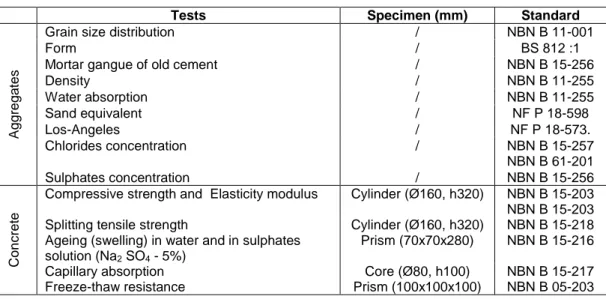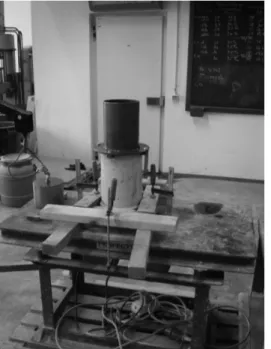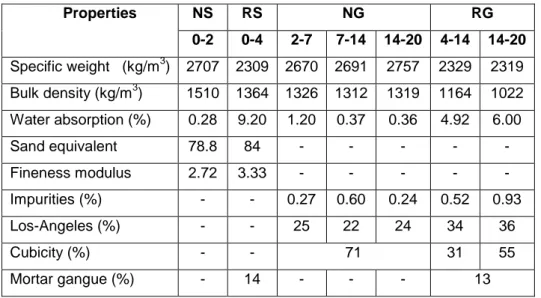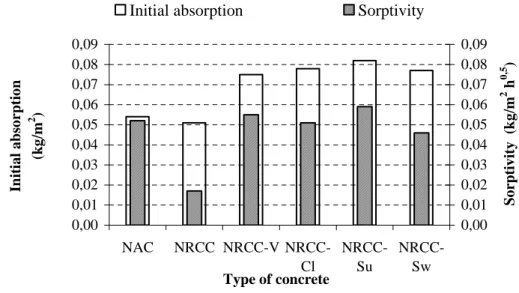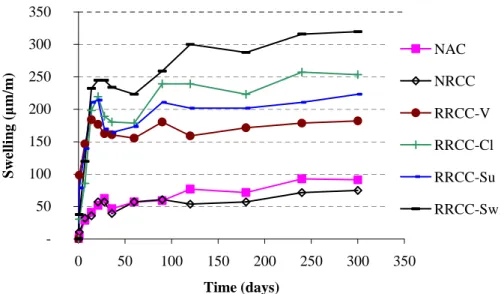USE OF CONTAMINATED RECYCLED AGGREGATES FOR
CONCRETE DESIGN: PROPERTIES AND DURABILITY
L. Courard and F. Michel
ArGEnCo Department, GeMME Building Materials University of Liège
Chemin des Chevreuils, 1 – 4000 Liège, Belgium e-mail: Luc.Courard@ulg.ac.be
web page: www.argenco.ulg.ac.be
F. Debieb
LPTRR Laboratory, Civil Engineering Department,University of Médéa, Algeria e-mail: Debieb.farid@univ-medea.dz
web page: www.univ-medea.dz/fr
Abstract
Construction waste management is a quite important economic and environmental deal for our societies. More than 2 million tons demolition and construction wastes are annually produced only in Wallonia, Southern Region of Belgium; recycling has clearly to be promoted. Roller Compacted Concrete (RCC) is a special dry concrete made of aggregates, water and low quantity of cement, laid down and compacted like a soil, for the construction of massive structures like dams or large horizontal surfaces like road foundations. Replacement of natural aggregates by concrete road recycled aggregates in the mix design of concrete is a solution to decrease nature depletion. Natural concrete slabs were cured in water, sea water, chloride solutions or sulphate solutions and then crushed to obtain virgin and contaminated (polluted) recycled aggregates. The aim of this research is the total replacement (100% coarse and fine) of natural aggregates (NA) by recycled concrete aggregates (RA) in the composition of a roller compacted concrete. The natural and recycled aggregates are characterised and compared. The mechanical properties and durability performances of concrete with contaminated RA are analysed.
The experimental results showed that the polluted RA are much richer in chlorides than in sulphates and are leached if they are soaked in water. Significant differences were observed between the properties of original and new concrete and the results demonstrated the need of taking these contaminations into account.
Keywords: rigid pavement, concrete, recycling, compatibility, compaction, contamination, durability
1 INTRODUCTION
Roller Compacted Concrete (RCC) has the same basic ingredients as conventional concrete [1, 2, 3]: cement, water, sands and aggregates. But unlike conventional concrete, it's a drier mix-stiff enough to be compacted by vibratory rollers [4]. Typically, RCC is constructed without joints. It needs neither
forms nor finishing, nor does it contain dowels or steel reinforcing. If well designed [1, 5], the RCC will develop high compressive strength and good durability, i.e. 40 N/mm² at 3 days for a cement content of 300 kg/m³ and a W/C ratio of 0.35 [6]. Moreover, this type of concrete is less sensitive to cracking in relation with drying shrinkage. In road construction, RCC is generally laid down in 20 cm thick by means of motor graders that will insure the flatness and uniformity of the surface. Compaction is assured by pneumatic-tyred rollers and finishing rollers. Belgian Guidelines [7] define the minimum requirements for such a type of concrete used in road foundations : BSC 20 and BSC 30 samples (100 cm² cores), with a cement content of minimum 200 kg/m³ and 250 kg/m³, respectively, must reach an average compressive strength of 20 and 30 N/mm², respectively, at the age of 90 days. Today, RCC is used for any type of industrial or heavy-duty pavement. The reason is simple. RCC has the strength and performance of conventional concrete with the economy and simplicity of asphalt.
On the other side, production of recycled aggregates coming from construction, renovation and demolition is increasing. Due to the large variety of their performances and origin, recycled aggregates offer variable properties, which may bridle reuse [8, 9, 10]. Concrete Road Recycled Aggregates generally present more constant properties due to the relative homogeneity of the source: hydraulic and bituminous concretes are the two main types of road recycled materials. They are consequently easier to reuse and qualify: common applications are road foundations, with or without cementitous binders. Limitations are usually coming from wear, attrition or low strength due to cement paste content. Contamination may also induce some restriction in the reuse of recycled aggregates: this aspect is studied through the present research project.
2 DESCRIPTION OF MATERIALS AND TESTING PROCEDURES
2.1 MaterialsAn industrial Portland cement type CEM I 52,5 N from Belgium, with Blaine fineness of 385 m2/kg, density of 3130 kg/m3 and average compressive strength at 28 days of 64 MPa, was used for all concrete mixtures. It is one of the most frequent cements for concrete structures in Belgium, with a relatively low hydration rate and a limited content in sulphates.
Four Natural Aggregates (NA) fractions (coarse NG: 2/7, 7/14 and 14/20 and fine NS: 0/2) of limestone’s crushed rock are used for concrete design. After using a jaw crusher for a primary crushing and another with percussion for a secondary crushing, three other fractions (coarse Recycled Aggregates (RG): 4/14 and 14/20 and fine Recycled Sand (RS): 0/4) of RA are obtained and used for RCC design. Small (365x265x100mm) natural concrete slabs (with 100% of coarse and fine NA) manufactured in laboratory, are semi-immerged into contaminated water solution and exposed to capillary absorption [11]. Three aggressive solutions (Chlorides: NaCl-5% (Cl), Sulphates: MgSO4
7H2O-5% (Su), and sea water
1
(Sw)) have been prepared. After one year ageing, slabs are crushed to produce virgin or contaminated (polluted) RA, respectively.
The ageing (contamination) of the concrete is performed by means of capillary absorption and, immersion into solutions containing aggressive agents, in order to simulate the situation one can observe in structures and in road infrastructures. The phenomenon is accelerated by the regular reversal of the slabs (once per month). The Coarse (RG) and fine (RS) recycled aggregates are of two types:
• virgins or not polluted (V): produced from crushing of the non-ageing natural concrete slabs;
• polluted (Cl, Su or Sw): produced from crushing of natural concrete slabs aged in the three different aggressive solutions (Chloride, Sulphates and Sea Water, respectively).
The mixing water used for the different mixes is the distribution drinking water, free of impurities with a pH equal to 7.9. The different tests realized on aggregates and concrete are summarized in Table 1.
1
Composition of one liter of artificial sea water: 1000 g of distilled water, 30g of Na Cl, 6g of Mg Cl2 6H2O, 5g of Mg SO4 7H2O, 1.5g of Ca SO4 2H2O and 0.2g of KH CO3.
2.2 Concrete identification
For the study, four families of concrete are realized. Literary codes identify each mixture in a precise way:
• reference concrete (NAC) : natural concrete containing 100% of coarse and fine NA;
• reference RCC (NRCC) : Roller Compacted Concrete, containing 100% of coarse and fine NA;
• RRCC-V: Roller Compacted Concrete, containing 100% of coarse and fine virgin (not polluted)
RA, resulting from the crushing of not polluted natural concrete;
• RRCC-P: Roller Compacted Concrete, containing 100% of coarse and fine polluted RA,
resulting from the crushing of polluted natural concrete and is composed of three families :
o RRCC-Cl : for concrete polluted by chlorides (NAC-Cl);
o RRCC-Su : for concrete polluted by sulphates (NAC-Su);
o RRCC-Sw: for concrete polluted in sea water (NAC-Sw).
Table 1: Identification of tests realized on aggregates and concrete specimens
Tests Specimen (mm) Standard
Ag g re g a te s
Grain size distribution / NBN B 11-001
Form / BS 812 :1
Mortar gangue of old cement / NBN B 15-256
Density / NBN B 11-255 Water absorption / NBN B 11-255 Sand equivalent / NF P 18-598 Los-Angeles / NF P 18-573. Chlorides concentration / NBN B 15-257 NBN B 61-201 Sulphates concentration / NBN B 15-256 C o n c re te
Compressive strength and Elasticity modulus Cylinder (Ø160, h320) NBN B 15-203 NBN B 15-203 Splitting tensile strength Cylinder (Ø160, h320) NBN B 15-218 Ageing (swelling) in water and in sulphates
solution (Na2 SO4 - 5%)
Prism (70x70x280) NBN B 15-216 Capillary absorption Core (Ø80, h100) NBN B 15-217 Freeze-thaw resistance Prism (100x100x100) NBN B 05-203
2.3 Mix optimization
The natural concrete is based on the granular mix design developed at the Research Centre of Cement Industry (CRIC) in Belgium [12]. The RCC mix is based on the requirements defined in Belgian Guidelines RW99 [7] and the design of concrete mixes according to Faury theory [13]. The optimal compactness of RCC mixture is determined by optimization of the sand to aggregates ratio (S/G) and the water content corresponding to the highest compactness [12]. The coarse aggregates are soaked into water for 24 hours before mixing.
The RCC mixing procedure is about 6 minutes long. At the end of mixing, the concrete is put in two layers in the mould fixed on the vibrating table and vibrated each time during one minute. Specimens are compacted through an experimental procedure and device [11] developed in the Building Materials Laboratory (LMC) of the University of Liege in Belgium (Fig.1). This device allowed us to optimize the compactness of RCC by a vibratory compaction energy applied on cylinders to be used for concrete characterization.
The compactness is evaluated on samples of about 7.5 kg (Fig. 1-a). A weight of 20 kg is inducing a pressure of 10 kPa during the vibration (150 Hz). The volume of concrete really cast is measured
and compactness is deduced from the relation Vsolid/Vtotal. This will reduce the pores volume and
increase the compactness (Fig.1-b).
Figure 1a: Vibration Weighing Test system Figure 1b: Vibration Weighing Test principle
3 RESULTS
3.1 Aggregates qualification
3.1.1 Physical and chemical characteristics
The sieve analysis indicates that the grain size distribution of NA and RA used is comparable. However, RA are coarser than NA and fine content (<63µm) is higher for NA than RA. RA present relatively lower bulk density and higher water absorption compared to NA: the higher water absorption of RA is clearly due to the mortar gangue (Table 2). The RA used are less "hard" than the NA with an average Los-Angeles (LA) of 35% remaining lower than the allowable limit of 40% required by guidelines [7]. The shape of RA was irregular too. Visual observations show that the RA presents a rough cracked surface, whereas the surface is smooth for the NA. This confirms the large porosity of the RA. The coefficient of cubicity of the coarse NA is than that of RA. The coarse RA (especially fraction 2/14) contains a rather significant part (more than half) of particles which can influence negatively on the compactness of the RCC.
3.1.2 Contamination process
After one year of immersion into aggressive solutions (chlorides, sulphates or sea water), the rate of contamination by chlorides (% Cl) and sulphates (% Su) of the concrete slabs is very high.
Table 3 summarized the chlorides and sulphates content in NA, virgin and contaminated RA. These values are averages of measurements taken on two samples (approximately 200g of aggregates by sample) of aggregates for each type and each fraction, after 365 days of ageing for RA. One notes significant chlorides content in the contaminated RA, while the sulphates content is near to
that measured on the virgin RA. The chloride and sulphate contents measured on fine aggregates are higher than on coarse aggregates: this is due to the larger quantity of mortar in recycled sand.
Table 2:Physical and mechanical properties of natural and recycled aggregates
Properties NS RS NG RG 0-2 0-4 2-7 7-14 14-20 4-14 14-20 Specific weight (kg/m3) 2707 2309 2670 2691 2757 2329 2319 Bulk density (kg/m3) 1510 1364 1326 1312 1319 1164 1022 Water absorption (%) 0.28 9.20 1.20 0.37 0.36 4.92 6.00 Sand equivalent 78.8 84 - - - - - Fineness modulus 2.72 3.33 - - - - - Impurities (%) - - 0.27 0.60 0.24 0.52 0.93 Los-Angeles (%) - - 25 22 24 34 36 Cubicity (%) - - 71 31 55 Mortar gangue (%) - 14 - - - 13
According to the standards (EN 206), the maximum chloride content in the RA is limited to 0.06%. The Swiss recommendation (SIA 162/4), concerning the recycled concrete aggregates used for hydraulic concretes, imposes the limits of 0.12% (mass of the primary concrete) for reinforced concrete and of 0.03% for prestressed concrete. The French standard (NF P 18-541) limits the sulphates content (expressed in SO3) in the aggregates for concrete to 0.15% by mass. In addition,
the RILEM [14] recommendations admit for the design of concrete with recycled aggregates a sulphate content of 1% (expressed by mass of SO3).
Table 3:Chlorides and sulphates content in the aggregates
NS 0/2 RS 0/4 2/7 mm 4/14 mm 7/14 mm 14/20 mm % Cl % Su % Cl % Su % Cl % Su % Cl % Su % Cl % Su NG - - 0.033 0.669 - - 0.064 0.510 0.157 0.471 RG-V - - - - 0.083 3.439 - - 0.083 3.229 RG-Cl - - - - 4.246 - - - 4.629 - RG-Su - - - 4.365 - - - 4.321 RG-Em - - - - 2.234 3.274 - - 3.256 4.405 NS 0.073 0.845 RS-V 0.099 4.172 RS-Cl 3.079 - RS-Su - 5.814 RS-Em 1.105 5.691
In practice, the RA resulting from structural crushed concrete, roadways concrete and the
the greatest part is combined in hydrated cement structure (ettringite) and does not produce a significant expansion of mortar and of concrete.
3.1.3 Leaching tests
After 15 days of total immersion in water, the coarse RG-Cl, lost up to 96% of their chlorides (Fig. 2); the content becomes comparable with that of NA. These chlorides are consequently free chlorides because they can go out from concrete after an adequate leaching. This result is very significant in practice where the use of RA remains so far limited because of the aggressive agents which they can contain and especially the great mistrust of the users.
0,12 0,0 1,0 2,0 3,0 4,0 5,0 0 10 20 30 Time (days) C h lo ri d es co n ten t (% ) RA-Cl (4/14) RA-Cl (14/20)
Figure 2: Chlorides content in coarse RA soaked in water (d) days (leaching of coarse RA rich in chlorides)
This leaching means that chloride may diffuse during hardening and setting periods and eventually modify hydratation process. Moreover, because it is necessary to saturate recycled aggregate with water before mixing, they could loose a large part (more than 50%) of chlorides during saturation process. That is the reason why, for the manufacture of the recycled concretes, these aggregates have been soaked in contaminated solution 24 hours before mixing.
That means also that, with a good washing or a total immersion into water during at least two weeks, the RA can be used in concrete design even in reinforced or prestressed concrete without any risk of chloride corrosion.
3.2 Properties of fresh concrete
The average density (2267 kg/m3) of RRCC concrete family is lower than reference concrete NRCC
(2462 kg/m3) and the natural concrete NAC (2391 kg/m3). The lower density of the RA is probably the main reason in spite of the vacuums of concrete compaction.
3.3 Properties of hardened concrete 3.3.1. Strength and elasticity modulus
The compressive strength (Rc), the splitting tensile strength (Rt) and the elasticity modulus (E) are presented in Table 4. If we compare NRCC with NAC (with the same type of cement and natural aggregates), we can conclude that the compaction improves well (an average increase of 13%) the compressive strength of the RCC. The RRCC concrete present an average 30% decrease in
compressive strength and a significant decrease (∆Rt/Rt) in splitting tensile strength of approximately 56% compared to reference concrete (NRCC).
It appears that the RA are the origin of this loss of strength. On the other hand, the contamination of the recycled aggregates does not have a significant effect on strength. This result is confirmed by Ouellet [6] who concluded that flexural strength of the RCC is not sensitive to the variations of the water/cement ratio but rather to the nature of the aggregates. The marked influence of the type of aggregate tends to confirm that the tensile strength is largely affected by the propagation of the cracks in the material.
Table 4: Mechanical properties of concrete
Rc (MPa) ∆Rc/Rc (%) Rt (MPa) ∆Rt/Rt (%) Rt/Rc E (GPa) ∆E/E (%) NAC 40 0 3.1 0 0.08 30.8 0 NRCC 46 0 5.7 0 0.12 32.5 0 RRCC-V 32 30 2.6 56 0.08 22.8 32 RRCC-Cl 31 2.4 22.7 RRCC -Su 32 2.5 21.9 RRCC -Sw 33 2.5 21.4
The RRCC present an approximate loss of 32% in modulus of elasticity (∆E/E) compared to its reference concrete NRCC. This reduction can be explained by the lower modulus of elasticity of the cement gangue of which the RA are partially made up. Like for compressive strength, the RA contamination has not a significant effect on the tensile strength or the modulus of elasticity.
3.3.2 Water absorption
The filling of the large capillaries (translated by initial absorption into kg/m2) and the finer capillaries (translated by the sorptivity into kg/m2 h0.5) of the concretes are presented on Fig. 3.
For all the concretes, initial absorption is higher than the sorptivity. This result confirms the importance of water absorption during the first moments to evaluate the porosity of concrete surface and even of the RCC. The initial water absorption of the RRCC is in the limits of this type of concrete family, and sometimes reaches up to the double that of reference concrete NRCC.
0,00 0,01 0,02 0,03 0,04 0,05 0,06 0,07 0,08 0,09 NAC NRCC V NRCC-Cl NRCC-Su NRCC-Sw Type of concrete In it ia l a b so rp ti o n (k g /m 2 ) 0,00 0,01 0,02 0,03 0,04 0,05 0,06 0,07 0,08 0,09 S o rp ti v it y (k g /m 2 h 0 ,5 )
Initial absorption
Sorptivity
This result was foreseeable because of the high absorption of recycled sand (9%). Secondly, it is interesting to mention that, with 100% of RA, the sorptivity of the RRCC concretes family is comparable with natural concrete (NAC): that is undoubtedly due to the compaction. Recycled concretes type RRCC, seem to have a higher capacity for water absorption than for natural concrete. The contamination of the recycled aggregates doesn’t seem to have any significant effect on water absorption of the RRCC.
3.3.3 Freeze-thaw resistance
After 14 cycles of freeze-thaw, the visual specimen’s examination did not detect any significant deterioration for all the concretes, except a very light scaling on some faces of the RRCC concretes family specimens [12]. The RCC with only natural aggregates (NRCC) resists very well to the winter severe climate; its behaviour after freeze-thaw cycles is comparable with that of the natural concrete (NAC).
The RRCC concrete family, with small capillaries, loses slightly more in mass than its reference concrete NRCC. RRCC-Sw presents a loss of mass approximately the double of other concretes type RRCC. This is due to the small scaling on some faces (mainly on the face on which the specimen is posed) of the concrete specimens in question.
3.3.4 Swelling
After one year of conservation into water, we did not observe significant swelling (Fig. 4) for all the concretes tested. It seems that the RA, and even the polluted RA, do not induce more swelling of RCC in water. It is clear that the energetic compaction of the concrete may act on swelling prevention.
0 25 50 75 100 0 50 100 150 200 250 300 350 Time (days) S w el li n g ( µ m /m ) NAC NRCC RRCC-V RRCC-Cl RRCC-Su RRCC-Sw
Figure 4: Swelling of concrete into water
Contrarily to the swelling in water, the storage (almost a year) in the sulphates (Na2SO4 -5%)
causes a new swelling which is higher, for all the concretes type RRCC (on average 100%), than the reference concrete NRCC (Fig. 5). The energetic compaction of concrete does not prevent additional swelling due to sulphates. Exceptionally for RRCC-Sw, the swelling is higher and can exceed 200%; the substitution of the ions Na2+ by Mg2+, due to the Na2SO4 solution, induces an additional swelling
- 50 100 150 200 250 300 350 0 50 100 150 200 250 300 350 Time (days) S w el li n g ( µ m /m ) NAC NRCC RRCC-V RRCC-Cl RRCC-Su RRCC-Sw
Figure 5: Swelling of concrete into sulphates solution (Na2 SO4-5%)
7 CONCLUSIONS
The following conclusions may be reached from the present investigations:
• Recycled aggregates are different from natural aggregates because of cement gangue of old
mortar which remains attached to the natural aggregates after crushing the original concrete and induces lower densities and greater capacity of water absorption;
• Recycled aggregates resulting from crushing of polluted concrete are richer in chlorides than
in sulphates;
• Recycled aggregates with chloride content are leached if they are soaked into water. That is the reason why, after a good washing or total immersion into water during a minimum of two weeks, these aggregates can be reused in concrete and even in reinforced or prestressed concrete without any risk of corrosion;
• Vibration Weighting Test (VWT) is simple and allows to obtain cylindrical samples suitable for
testing;
• The RCC containing only crushed concrete is comparable in compactness with the RCC
containing only natural aggregates. However, the compressive strength is better for the second type because of the better quality of the aggregates;
• The mechanical and durability tests realized on RCC containing only crushed concrete, show
that this type of concrete has an acceptable behaviour with time, which is favorable for road construction (for example sub-base).
Consequently, the chloride or sulphate ion content doesn’t seem to have any influence on the mechanical properties of Roller Compacted Concrete. As RCC doesn’t usually requires reinforcement, the chemical degradation that could be induced by chlorides are not fundamental however, swelling in presence of sulphates, probably caused by ettringite formation and Na to Mg substitution, has to be taken into account in evolution of durability. The chemical characterization of recycled aggregates potentially containing hazardous ions is of prime importance in order to avoid disturbance.
ACKNOWLEDGMENT
This publication was made possible by the cooperation agreement between the Federation Wallonia-Brussels (Belgium) and the Republic of Slovenia.
The research project was financially supported by the Belgian Technical Cooperation Agency.
REFERENCES
[1] Ouellet E. Design and study of the mechanical behaviour of Roller Compacted Concrete, Master Thesis 1998, Université Laval (Qc), Canada (in French).
[2] Use of Roller Compacted Concrete for roads, Technical Committee for Concrete Roads, PIARC, France, 1993.
[3] Guerinet M. Roller Compacted Concrete (1997) Ecole Nationale des Ponts et Chaussées. Ponts formation édition, p.17-29 (in French).
[4] Burns Cecil D, Saucier Kenneth L. (1978) Vibratory Compaction Study of Zero-Slump Concrete. ACI Journal; 75 (3): 86-90.
[5] Tremblay S. Design methods for Roller Compacted Concrete and effect of Air Entraining Agents on Consistency. Master Thesis 1997, Université Laval (Qc), Canada: 16-80 (in French).
[6] de Larrard F, Marchand J, Pouliot N, Sedran T. (2001) Prediction of the compacity of Roller Compacted Concrete by means of a granular compacting model. Bulletin des Laboratoires des Ponts et Chaussées 233: 23-36 (in French).
[7] Qualiroute, Technical and Administrative Regulations for roads and highways, Wallonia Public Administration (www.qc.met.wallonie.be) (in French).
[8] Belleflamme M. Recycled Aggregates and CE marking. Master Thesis 2004. Faculté des Sciences Appliquées, Université de liège, 145p (in French).
[9] Levy Salomon M, Helene P. (2004) Durability of recycled aggregates concrete: a safe way to sustainable development. Cem Concr Res 34 (11): 1975-80.
[10] Gomez-Soberon J. (2002) Porosity of recycled concrete with substitution of recycled concrete aggregate: An experimental study. Cem Concr Res 32:1301-11.
[11] Courard L., Michel F. and Delhez P. (2010) Use of Concrete Road Recycled Aggregates for Roller Compacted Concrete. Construction Building Materials 24(3): 390-395.
[12] Debieb F., Courard L., Kenai S. and Degeimbre (2009) R. Roller Compacted Concrete with contaminated recycled aggregates. Construction Building Materials 23(11): 3382-87.
[13] Debieb F. Performances and durability of concrete designed with aggregates polluted by chlorides and sulphates. Ph.D. Thesis, Department of Civil Engineering, University of Houari Boumediene of Algiers, 2007 (in French).
[14] RILEM TC 121-DRG: Specifications for concrete with recycled aggregates. Materials and structures 27 1994: 557-559.
